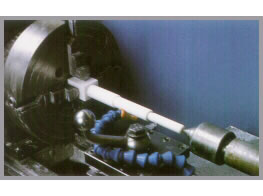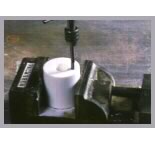 |
| Speeds and
Feeds |
| 1. |
Cutting
Speed 9 to 45m/min (30 to 150 sfpm) using carbide tools.
Speed is limited to 15m/min (50 sfpm) when using high speed steel cutters |
| 2. |
Feedrate .05
to .13 mm/rev (.002"to .005"per rev) |
| 3. |
Depth of cut
up to 6.3 mm (.250") |
| 4. |
When
threading depth of cut should not exceed .04mm (.0015") |
 |
| Tool
Suggestions |
| 1. |
Carbide C2
or equal suggested for best life |
| 2. |
Tool should
have zero to 5° positive rake angle |
| 3. |
Use an “up
sharp” tool. No honed edge |
| 4. |
A nose
radius of .38mm (.015") or larger will help minimize chipping |
| 5. |
Using a tool
with side cutting angles from 15° to 45° allows for increased feedrates |
|
|
|
Sawing MACOR® MGC
|
| 1. |
Macor can be
sawn with a bandsaw. Carbide grit edge blades work well with a blade speed of 30
m/min (100 sfpm). |
| 2. |
Toothed
blades of high speed steel can be used but blade life is short. Teeth should be
small without chip breakers. |
| 3. |
Thin diamond
wheels are effective. Coolant must be used. Wheel speed of 1800 m/min (6000
sfpm), depth of cut up to .25mm (.010") table traverse rate 6 m/min (20 fpm). |
|
|
|
Grinding MACOR® MGC
|
| 1. |
Aluminum
oxide, silicon carbide or diamond wheels can be used. They must be constantly
monitored to ensure the wheel is sharp. A dull wheel will cause surface cracks.
Diamond is vastly superior. |
| 2. |
Aluminum
oxide and silicon carbide wheel grades 36 or finer with open grain. |
| 3. |
Diamond
wheels 100 to 220 grit (US mesh size) work exceptionally well. |
| 4. |
Coolant must
be used. |
| 5. |
Downfeeds
with aluminum oxide and silicon carbide should not exceed 13 microns (.0005"). |
| 6. |
Downfeeds
with diamond can be up to .5mm (.020") |
| 7. |
Table
traverse rate up to 3 m/min (10 fpm) |
| 8. |
Crossfeeds
up to one half the wheel width. |
| 9. |
Grinding can
be done in both directions. A sparkout pass is not necessary. |
|
|
|
Polishing MACOR® MGC
|
| 1. |
Polishing
can be performed wet or dry. |
| 2. |
Rough plano
polishing: steel disk rotating 60 m/min (205 sfpm), A-700 paper with 300 g/cm2
(4.5 psi) down force. Best done wet. |
| 3. |
Mirror plano
polishing: steel disk rotating 140 m/min (465 sfpm), A-2000 paper with 300 g/cm2
(4.5 psi down force. Best done dry. |
| 4. |
Curved
surfaces can be polished with cerium oxide powders using standard optical
polishing techniques |
|
|
|
General Considerations When Machining MACOR® MGC
|
| 1. |
Thoroughly
deburr all workholding devices. |
| 2. |
Protect the
MACOR® from direct contact with the hard surfaces of the workholders.
Tape is a good choice. Where critical tolerances are required this cannot be
done. |
| 3. |
Avoid
clamping on the edge of the MACOR®. If it cannot be avoided, round
the edge of the MACOR® at least .25mm (.010") |
| 4. |
Avoid
cutting in a direction that puts the MACOR® under tensile stress at
an edge. |
| 5. |
Waxes are a
good work holding material. Avoid heating and cooling the MACOR® at a
rate greater than 200°C/hr. Temperature differences on the MACOR®
part during heating should not exceed 48°C (118°F). |
| 6. |
Where
features go through the MACOR®, machining can be performed from both
faces to minimize chipping. |
| 7. |
MACOR®
is a brittle material that should be inspected for flaws prior to use. Machining
damage will usually be open and closed chips at an edge, small surface cracks on
machined surfaces usually due to dull tools or cracks from excessive workholding
or cutting forces. Flaws in parts up to 3mm (.125") thick can be inspected by
shining a bright light through the material. The flaws will appear as shadows or
bright lines. Alternately, any of the industry standard colored dye penetrants
may be used. Follow all manufacturers recommendations and safety instructions. |
| |
|







